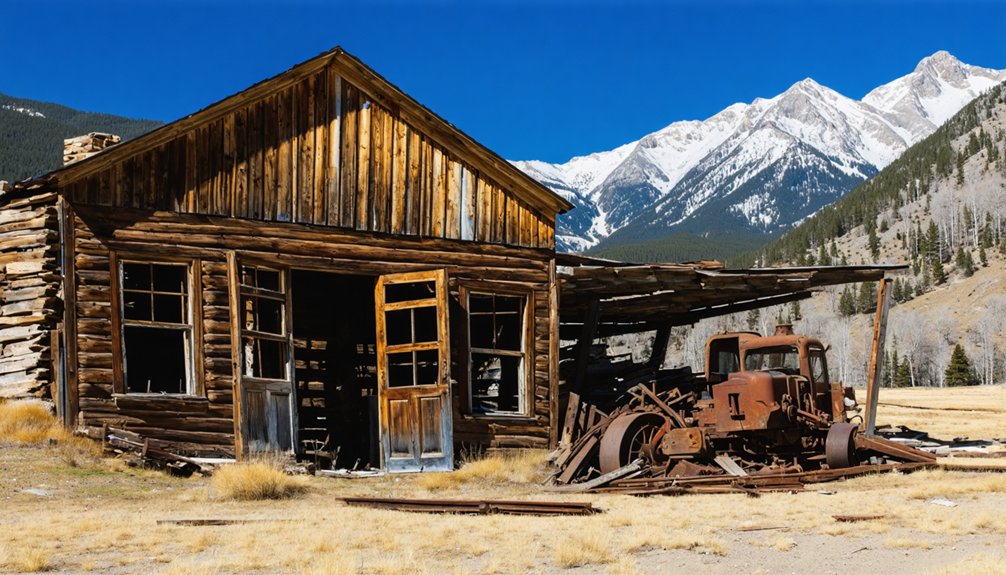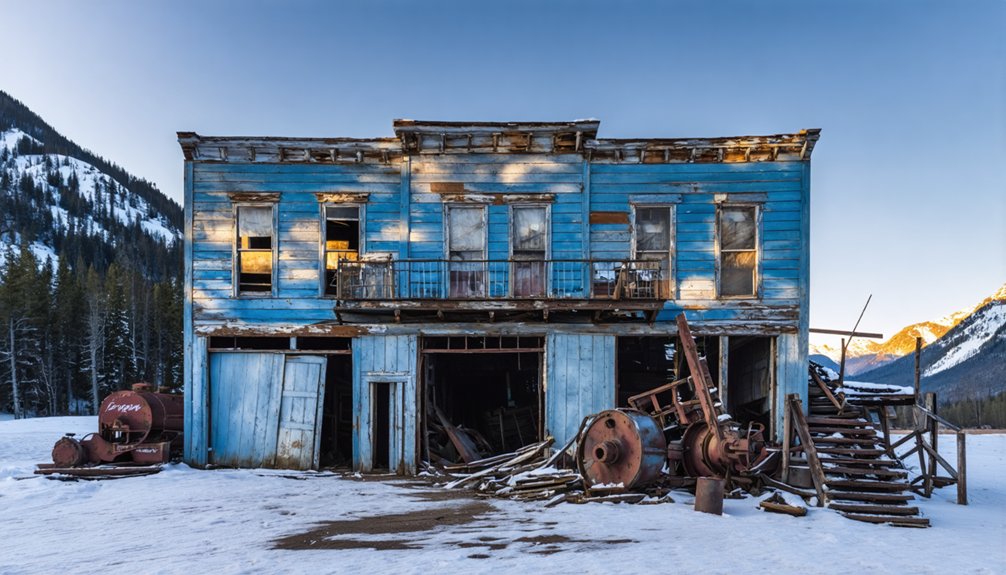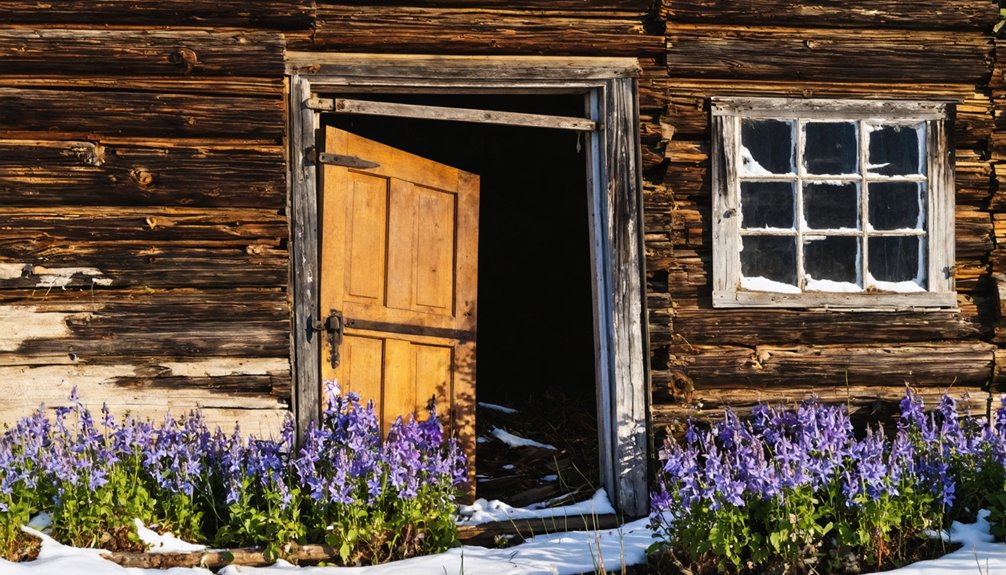You’ll discover Kokomo as a former silver mining town perched at 10,695 feet in Colorado’s Rocky Mountains. After its 1878 founding, it boomed to nearly 10,000 residents before an 1881 fire marked its decline. Unlike typical ghost towns, Kokomo’s remains lie completely buried beneath the Mayflower Pond tailings facility since the 1960s. Only historical markers on Highway 91 commemorate where this once-thriving community surrendered to mining’s evolution.
Key Takeaways
- Kokomo was a silver mining boomtown that reached 10,000 residents in 1881 before declining due to fire and falling silver prices.
- Located at 10,695 feet elevation in Colorado’s Tenmile District, Kokomo faced harsh winter conditions that challenged survival.
- The town was officially disincorporated in 1965 and completely abandoned when Climax Molybdenum Company purchased the land for tailings dumps.
- Kokomo now lies buried beneath the Mayflower Mill Tailings Pond, with no visible structures remaining above ground.
- A historical marker on Highway 91 commemorates the site of Kokomo, which represents a unique archaeological preservation of an 1880s mining town.
The Silver Rush Origins: How Kokomo Came to Be
While gold was first discovered in the Tenmile District as early as 1861, Kokomo’s true beginnings emerged from the silver rush that transformed Colorado’s mining landscape.
Throughout the 1860s, modest placer gold discoveries attracted some interest, but extraction was hampered by blue-black sands containing lead carbonate.
Kokomo’s origins were dramatically reshaped in 1877 when rich silver deposits in nearby Leadville sparked widespread prospecting.
Prospectors ventured to higher elevations near Kokomo seeking similar silver treasures, which they found in the summer of 1878. This mining settlement became one of several locations sharing the Kokomo name across America.
Located at an impressive 10,695 feet elevation, Kokomo faced harsh environmental challenges that contributed to its eventual decline.
The government’s silver purchase act that same year boosted prices, accelerating development.
Life at 10,000 Feet: Daily Existence in a High-Altitude Mining Town
Residing at over 10,000 feet, you’d face brutal winter survival challenges that required stockpiling food and fuel months in advance, while sharing cramped wooden homes that huddled together for protection against howling winds and deep snowdrifts.
Your family life above timberline meant adapting to hypoxia, teaching children to navigate dangerous terrain, and developing community support networks to survive seasonal isolation. As Kokomo’s population grew to nearly 10,000 residents during its peak, these support networks became increasingly vital to the town’s survival. The limited access via trails in 1878 made obtaining supplies particularly difficult during winter months.
Despite these hardships, you’d find relief in Kokomo’s vibrant social scene, where the Freemason lodge, busy saloons, and community gatherings provided essential respite from the physical demands of mining life.
Brutal Winter Survival Strategies
At 10,618 feet above sea level, winters in Kokomo presented brutal challenges that required sophisticated survival strategies from residents.
You’d face subzero temperatures, trails buried under snow, and storms that isolated the town for days. Winter hardships included frozen water sources, requiring you to melt snow for daily use.
Your survival tactics would center around shelter modifications—compact wooden buildings with layered insulation and central wood stoves to combat the bitter cold.
You’d carefully ration firewood and wear wool layers and animal hides against frostbite risks. Food preservation became critical as you’d rely on salted meats and dried beans when fresh supplies couldn’t reach town. Travel was especially difficult as residents endured journeys in cramped wagons, effectively becoming wool-clad sardines in the bitter winter conditions.
Underground storage protected root vegetables from freezing solid, while mining continued year-round despite shorter daylight and treacherous conditions.
Family Life Above Timberline
Family life in Kokomo unfolded in a harsh landscape where the thin air at 10,618 feet shaped every aspect of daily existence.
You’d find most families living in modest wooden structures with small footprints, built to withstand heavy snowfall on limited flat terrain. Family dynamics often extended beyond the nuclear unit to include relatives or boarders who shared both housing and labor responsibilities.
Your children would attend one-room schoolhouses when weather permitted, their education frequently interrupted by brutal winters or mining-related relocations.
For health challenges, you’d rely on home remedies and communal support networks, as professional medical care remained scarce. Women managed domestic labor despite frozen water sources and limited supplies, while men worked the mines. The devastating fire in 1881 destroyed many homes and businesses, forcing families to rebuild their lives from scratch.
The Masonic Lodge, established in 1882, provided essential social connections that strengthened community bonds.
Mining Town Social Scene
Life in Kokomo’s social scene revolved around the simple pleasures that made the harsh realities of high-altitude existence bearable.
You’d find community events centered around the Free Mason lodge established in 1881, which served as an essential gathering place for nearly 85 years until 1966.
Despite the town’s wooden construction and vulnerability to fire, residents maintained a vibrant social life across multiple hotels and stores. Social gatherings occurred regularly, connecting the 10,000 residents who called this 10,618-foot elevation home during the boom years.
When neighboring Robinson residents joined community events, the collective population created a lively atmosphere despite isolation on narrow mountain trails.
Even as mining production declined in the 1880s, the social fabric remained intact, with the post office serving as a communication hub throughout the town’s existence. The town had been previously known as Ten Mile before it was renamed to Kokomo.
The Great Fire of 1881: Devastation and Rebuilding
As you’d gaze at Kokomo in October 1881, you’d have witnessed smoke-filled skies as flames consumed the wooden structures of this once-thriving mining community.
The resilient residents immediately began rebuilding their mountain town, with the Corinthian Masonic Lodge No. 42 receiving special dispensation to re-establish itself by January 1882. The Lodge held its first meeting on May 3, 1881, before the devastating fire later that year. Similar to the Huron County disaster, the fire’s rapid spread created panic among residents as they sought safety from the engulfing flames.
This devastating blaze effectively crushed the silver dreams of many, accelerating Kokomo’s economic decline and ultimately leading to its merger with neighboring Racen as the town never regained its former glory.
Smoke Filled Skies
The winter of 1881-82 brought catastrophic change to Kokomo when a devastating fire swept through the hastily-built mining camp, leaving dense smoke hanging over the mountain town and reducing most wooden structures to ash.
You would’ve struggled to breathe or see through the toxic haze that enveloped the settlement. The environmental effects were severe, with smoke-filled skies creating conditions similar to the Great Thumb Fire in Michigan that same year.
Yellow-hued daylight filtered weakly through the dense smoke while firefighters battled blindly against advancing flames.
At 10,618 feet elevation, the health risks were magnified as residents already contending with thin mountain air now faced smoke inhalation in freezing temperatures.
The aftermath required significant relief efforts, similar to how Clara Barton mobilized the American Red Cross for its first disaster operation following the Michigan Thumb Fire.
These harsh conditions compounded the economic and psychological toll on survivors attempting to rebuild their lives.
Resilient Mining Community
Despite facing total devastation after the 1881 fire, Kokomo’s residents launched into rebuilding efforts almost immediately, demonstrating the resilient spirit that characterized frontier mining communities.
At 10,618 feet elevation, the remote location made reconstruction challenging, yet citizens persisted in restoring their town.
The community’s mining heritage remained evident through three key developments:
- The Kokomo Masonic Lodge received its charter in 1881, symbolizing community resilience despite the fire.
- Residents replaced wooden structures, prioritizing essential infrastructure like banks and smelters.
- Social institutions persisted, maintaining governance and community identity through the crisis.
Though Kokomo never regained its pre-fire population of 10,000, the rebuilding efforts reflect the determination of frontier settlers unwilling to surrender their mountain home to disaster.
Silver Dreams Crushed
When flames tore through Kokomo’s wooden structures in the winter of 1881-82, they devoured more than buildings—they consumed the very future of what had been a thriving silver mining town of 10,000 residents.
This disaster, the second major fire since 1879, highlighted the inherent mining risks of hastily constructed boom towns at 10,618 feet elevation.
You would’ve witnessed the town’s silver legacy crumble as critical infrastructure—homes, businesses, supply stores, and smelters—turned to ash.
Despite immediate rebuilding efforts, the fire accelerated Kokomo’s decline, forcing survivors to merge with neighboring Recen.
The economic foundation was already unstable, with mines producing less silver, and the fire delivered the decisive blow.
What couldn’t burn was eventually abandoned, with the town finally disincorporating by the mid-1960s.
Winter’s Wrath: Surviving the 71-Day Blizzard of 1889
During the harsh winter of 1889, residents of Kokomo faced an unprecedented natural disaster as a massive blizzard battered the Colorado mining town for an astonishing 71 consecutive days.
The blizzard impact was devastating, with seven-foot snow depths on flat ground and twenty-five-foot drifts isolating the community from essential supply lines.
You’d have witnessed a transportation system collapse that threatened survival as food supplies dwindled to just ten days’ worth of provisions.
Community resilience emerged through three critical phases:
- Recognition of impending starvation as railroad tracks became impassable
- Desperate efforts by railroad workers to clear blocked routes
- Ultimate restoration of supply deliveries, preventing mass casualties
Despite this brush with catastrophe, Kokomo persisted for decades afterward, though population steadily declined from 768 in 1880 to 193 by 1910, before the town’s final demise in the 1960s.
Boom to Bust: The Economic Cycles of a Mining Community

You’ll find Kokomo’s economic story written in the rise and fall of precious metals, as silver strikes in 1878 catapulted the town to a population of 10,000 by 1881.
The devastating fire of 1881, followed by declining ore quality and silver prices, rapidly transformed the boomtown into a struggling settlement with diminishing prospects.
Later mining operations for molybdenum delivered the final blow, as tailing ponds from these activities eventually buried what remained of the once-thriving mining metropolis.
Silver’s Rise, Fall
Nestled high in the Tenmile Valley, Kokomo exemplified the classic boom-to-bust cycle that characterized so many western mining communities in the late 19th century.
The silver mining rush began in 1878, transforming this mountainside into Colorado’s highest incorporated town with 10,000 residents by 1881.
You’d have witnessed three distinct phases in Kokomo’s silver saga:
- The explosive growth (1878-1881) – bank, hotels, and smelter established as silver production soared
- The devastating 1881 fire – marking the beginning of decline despite rebuilding efforts
- The gradual abandonment (1881-1960s) – dwindling population as accessible silver veins depleted
Despite brief moments of community resilience, like the 1921 Silver Queen Mine strike, Kokomo eventually succumbed to the harsh economic realities of depleted resources and falling silver prices.
Molybdenum’s Final Blow
While silver’s boom-and-bust cycle left Kokomo struggling for survival, the discovery of molybdenum nearby would ultimately seal the town’s fate. In 1879, Charles Senter discovered a massive molybdenite deposit on Bartlett Mountain, but its value wasn’t recognized until 1895.
Climax Molybdenum Company formed in 1918, transforming the region’s mining landscape. After World War I, the company expanded into new markets, with molybdenum production reaching record levels by 1966. The company’s ambitious $20 million investment in mining technology to recover molybdenum oxide ultimately failed, but their influence continued to grow.
In the 1960s, Climax purchased Kokomo’s land for a tailings dump. The town’s population reached zero as residents departed, sacrificed to the industrial demands of modern molybdenum production, leaving behind only memories of a once-thriving community.
Final Residents: Stories From Kokomo’s Last Inhabitants
As Kokomo shifted through its final decades, the stories of its last inhabitants reveal a community in gradual decline.
You’d find these last residents clinging to a semblance of normal life while their town gradually disappeared around them.
During the 1940s-1960s, resident stories captured three distinct phases of Kokomo’s final chapter:
- The employment period when 100-200 people lived in company housing, sending their children to the winter school.
- The voting period when nine remaining citizens formally voted to disincorporate their town in 1965.
- The departure phase as Climax Molybdenum Company systematically purchased properties, forcing the last memories to be formed before 1973.
The post office’s closure in 1965 marked the end of official services, though a bar and restaurant continued operating until the final evacuation.
The Climax Mine’s Expansion and Kokomo’s Sacrifice

The fate of Kokomo was sealed when AMAX’s Climax Mine launched an ambitious $2 billion expansion project in the late 1950s.
As the world’s largest underground molybdenum operation, producing 35,000 tons daily with 1,800 workers, the mine needed space for growth.
You’d hardly recognize Kokomo by the 1960s—reduced to just a bar and restaurant before Climax purchased the land for tailings dumps.
The post office closed in 1965, and by the early 1970s, mining waste buried all physical traces of the community.
Meanwhile, the company relocated its own town’s 1,600 residents to West Park in Leadville, moving 500 homes 12 miles downhill.
Kokomo’s legacy represents a common but troubling pattern in mining ethics—sacrificing communities for industrial expansion without preserving their history.
Beneath the Tailings: What Lies Under the Mayflower Pond
Beneath the placid surface of Mayflower Pond lies an entire community frozen in time, preserved like a historical time capsule under layers of mining waste. You’d never guess that the bluish-silver pond at 10,495 feet covers what was once a thriving town with 100-200 residents until 1973 when Climax Molybdenum began filling the area with tailings.
Archaeological discoveries remain untouched beneath the pond:
Frozen in time, a historical treasure trove sleeps beneath the silvery waters, undisturbed and perfectly preserved.
- Municipal buildings including a post office, restaurant, and bar
- Residential homes from the silver boom era of 1881
- The rebuilt town that emerged after the devastating 1881-82 winter fire
While the environmental impact of this burial seems drastic, it’s worth noting that the Mayflower Mill Tailings Pond was actually an innovative solution to prevent river pollution—a pioneering effort in responsible mining waste disposal.
Photographic Journey: Kokomo Through the Decades

While the story of Kokomo’s burial beneath Mayflower Pond reveals what lies hidden underwater today, historical photographs offer us a window into what once stood proudly above ground.
In late 19th century images, you’ll see a bustling mining town with wooden structures—log houses with painted facades and primitive mining techniques visible throughout. The town’s 10,618-foot elevation is evident in photos showing narrow mountain trails leading to this remote settlement.
After the devastating 1881 fire, photographs document Kokomo’s valiant rebuild and gradual decline.
By mid-20th century, images reveal a shrinking community before Climax Molybdenum Mine began acquiring land.
The 1960s photos show the ghost town’s final chapter as buildings were demolished or abandoned, with tailings pond construction gradually erasing what remained of this once-thriving mountain community.
Ghost Town Tourism: Finding Traces of Kokomo Today
What remains of Kokomo today presents a unique challenge for ghost town enthusiasts seeking tangible connections to Colorado’s mining past. Unlike other mining settlements, you won’t find crumbling buildings or abandoned streets—the town lies buried beneath mining tailings, its physical presence erased by industrial operations in the 1960s.
To experience Kokomo’s ghostly legends today:
- Visit the historical marker commemorating the Masonic Lodge that stood until 1966.
- Follow coordinates (39°25′27″N 106°11′23″W) to stand above where hidden treasures and foundations remain entombed.
- Explore the Kokomo Landmark on Highway 91, about 10 miles south of Leadville.
While physical structures have vanished, Kokomo’s story remains integral to Summit County’s mining heritage tourism circuit.
Frequently Asked Questions
Did Any Celebrities or Notable Figures Visit Kokomo During Its Heyday?
You won’t find evidence of celebrity sightings in historical records. Despite reaching 10,000 residents, Kokomo’s remote location and challenging accessibility prevented notable visitors during its mining boom years.
What Indigenous Peoples Inhabited the Kokomo Area Before Mining Began?
The Ute tribe primarily inhabited the area before mining began. You’ll find their Native Tribes’ presence had Historical Significance as they roamed these mountains freely for generations before prospectors arrived.
Were There Any Significant Crimes or Wild West Shootouts in Kokomo?
You won’t find records of Wild West shootouts or significant crimes in Kokomo’s history. Unlike other mining towns, Kokomo’s challenges centered around fires and economic decline rather than lawlessness or violence.
What Happened to the Cemetery and Remains When Kokomo Was Demolished?
Like silent sentinels of the past, Kokomo Cemetery survived the town’s demolition. You’ll find no clear records of cemetery relocation or remains preservation, though it remained visible while mining operations consumed surrounding lands.
Did Kokomo Have Any Unique Local Traditions or Celebrations?
You’d find no unique local festivals in Kokomo. Masonic meetings, mining rituals, and rebuilding gatherings were typical of Colorado mining towns, with celebrations fading as the population declined by the 1960s.
References
- https://www.coloradocentralmagazine.com/kokomo-smaller-than-a-small-town/
- https://westernmininghistory.com/towns/colorado/kokomo/
- https://kekbfm.com/colorado-mining-towns-i-wanna-take-you-to-kokomo/
- https://www.ghosttowns.com/states/co/kokomo.html
- https://hegdetravelphotos.com/2023/08/14/kokomo-landmark-valley-of-ghosts/
- https://en.wikipedia.org/wiki/Kokomo
- https://en.wikipedia.org/wiki/Colorado_Silver_Boom
- https://mild2wildrafting.com/rafting-blog/silver-boom-made-southwest-colorado-roughest-mining-towns
- https://coloradogeologicalsurvey.org/minerals/metals/
- https://www.summitdaily.com/news/this-week-in-history-july-2-1921-kokomo-strikes-silver-pueblo-needs-aid/



